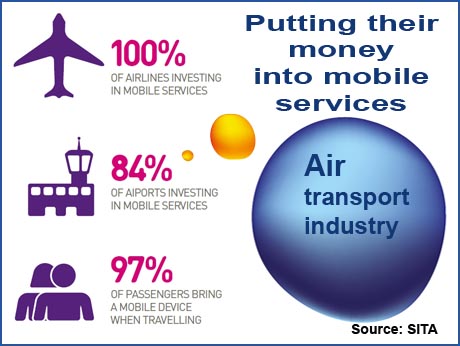
February 26 2015: The future is personal in air travel, but are passengers, airlines and airports aligned?
The “connected passenger” has become a reality for the air transport industry with 97% carrying a device.. Smartphones are the essential tool to help passengers navigate through the traditional pinch points on their journey and have a better experience, with 81% carrying them today, compared to just over a quarter in 2010. But global usage statistics indicate that passengers have been slow to adopt new airline and airport mobile services
Nevertheless, the ubiquity of mobile technology has already spurred airlines and airports to invest in mobile products to help air travelers on their journey and, as these begin to mature, new opportunities will open up to enable the air transport industry to deliver a more personal service.
The latest SITA Report 'The Future is Personal' says some industry players are bucking the trend and achieving high levels of usage. Approaching two thirds or so now enable passengers to buytickets, check-in and access flight information via smartphone apps. Their airport counterparts have been slower off the mark, but are starting to make headway.
The next three years will see all airlines and the vast majority of airports further investing in mobile services. However, service roll-out and user adoption is, perhaps inevitably, proving rather complex.
Today, about half of all passengers are keen to use mobile services that will support them at the pinch points of their journey through the airport, whether that is finding their way around, accessing lounges or the aircraft, providing identification at checkpoints, or making payments. Airlines are ahead of this demand in terms of their plans for mobile check-in and boarding passes via apps, yet passengers have yet to wholeheartedly embrace the service.
In fact about a quarter have yet to use smartphone apps on their journey. Similarly, while almost three quarters of global airports recognize that apps providing airport maps and directions are a key requirement for their passengers, implementations have been sluggish, albeit airports are planning to pick up the pace pretty rapidly over the next three years. In fact, both airlines and airports will continue to grow their existing mobile offers, with flight status, purchasing services and retail offers all moving comfortably mainstream by the end of 2017.
Looking ahead, the opportunity and the new frontier for mobilepassenger services will be using apps to improve customer relationships and enabling passengers to personalize theservices they use to suit their needs on their journey.
The report combines SITA’s global airline, airport and passenger research with commentary and case studies from stakeholders such as Alaska Airlines, easyJet, Emirates, JetBlue, Philippine Airlines, Qantas and SWISS as well as Cork Airport, Dubai Airports, Frankfurt Airport, Miami Airport, and Toronto Pearson International.
You can download the full report here ( registration required)